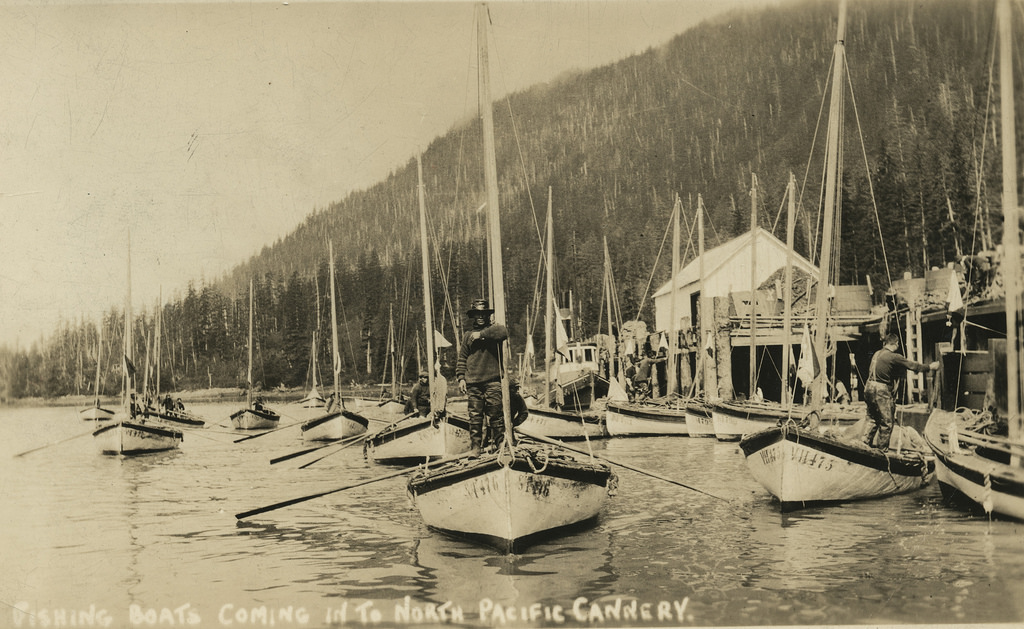When Canada declared war on Germany on September 10, 1939, a lot changed for Canadians. Yet how did World War Two affect North Pacific Cannery (NPC)? The answer is not a simple one. The war affected everyone in the nation, whether they dealt with rations, rising prices for goods, increased taxes, or had a personal connection by joining the war effort. NPC experienced some, if not all of these burdens during the war, yet they managed to continue to can salmon at a steady rate for most of the war. Before World War Two, NPC sold over $245,000 worth of canned salmon. Although that number slipped during 1941 and 1942, production was back to normal and at a higher level by 1943, when over $337,000 worth of canned salmon was sold, when calculated for inflation, that is over $4.8 million today in Canada. NPC also saw a decrease in white labourers due to the war, many of who never returned after the war. This led to a steady increase in Chinese labourers who maintained their former positions following World War Two.
With rations and an increase in the cost of goods, NPC spent more than double the cost of fuel in 1941 than they had in 1936. The amount spent on fuel increased even more throughout the war and by 1948 the cannery was spending almost $7,000 on fuel, when compared to just $2,500 in 1938 and $3,200 in 1942. Fuel was not the only thing that cost NPC more money during the war. The Mess House was becoming increasingly more expensive to operate as the war went on. In 1937 the Mess House cost $3,900 to operate a year. By 1941the annual cost of running the Mess House was over $6,000. The cost of running the Mess House never decreased following the end of the war, just as the cost of fuel did not decrease either.
One of the most interesting pieces of information about NPC during World War Two is that the amount of money spent on white labourers decreased, while the amount spent on Chinese labour increased. In 1937 NPC spent in total on white labourers $26,387, yet in 1939 and 1940, the amount paid to them in total was close to $21,000 for each year respectively and barely reached $22,000 total each in the years of 1941 and 1942 respectively. When compared to the amount spent in total on Chinese labourers in 1937 it was $15,234. By 1939 the total amount spent on Chinese labourers was $23,644, and the amount spent continued to grow over the course of the war. In 1940 $25,080 was spent on Chinese labourers, $30,408 in 1943, and $49,746 in 1945. While the amount spent on white labourers would increase to $45,970 in 1948, more money was spent on Chinese labourers in 1948 with $54,840 being spent on them in that year. However this data does not prove that Chinese labourers made more money than white labourers. It is likely that there were more Chinese labourers who made very little money, compared to a small number of white labourers who made much more money individually than a Chinese labourer did. What this data does prove is that NPC employed more Chinese labourers than white labourers during and after World War Two.
Overall NPC had to adapt to changes that occurred during World War Two. Some of those changes remained intact following World War Two, such as the amount spent on fuel and the mess house, and the reliance on Chinese labourers. There are many explanations as to why these changes occurred. Rationing and the struggle to get certain consumer goods, thus raising their cost, caused some of these problems. While White workers probably joined the war effort or looked for jobs where they could make more money, leaving skilled Chinese labourers behind to step up and fill rolls in which they never left.
Works Cited
“Account Book, 1934-1936,” Ledger, in MS2.48, North Pacific Cannery Archives, Port Edward, BC.
“Account Book, 1937-1939,” Ledger, in MS2.49, North Pacific Cannery Archives, Port Edward, BC.
“Account Book, 1940-1942,” Ledger, in MS2.50, North Pacific Cannery Archives, Port Edward, BC.
“Account Book, 1943-1945,” Ledger, in MS2.51, North Pacific Cannery Archives, Port Edward, BC.
“Account Book, 1946-1948,” Ledger, in MS2.52, North Pacific Cannery Archives, Port Edward, BC.
Bank of Canada Inflation Calculator.
